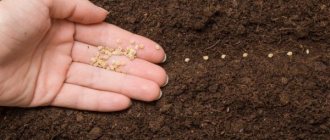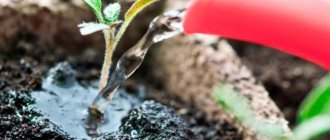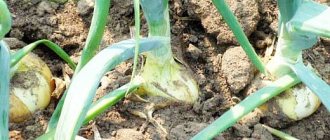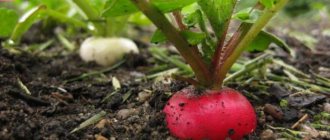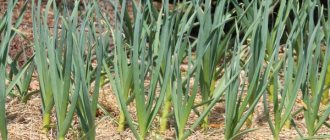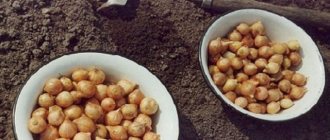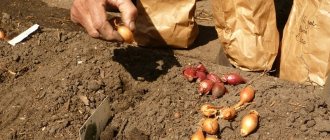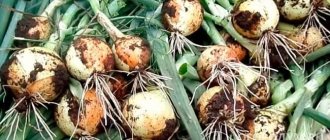Rules for watering onion sets after planting them in open ground
Due to its special taste and content of useful substances, onions are widely used in cooking and folk medicine. Gardeners strive to get a harvest of this valuable vegetable on their plots. However, growing onions from sets is not as simple as it seems. A good crop yield is ensured by proper watering of onions grown in open ground.
How to choose sets
It is important to choose the right quality planting material. The bulbs should not be wrinkled or already sprouted
In this case, their supply of nutrients has already gone to the feather, and you won’t get a good turnip.
Also inspect them for damage and rot, this is important because such sets will not make a good onion head, it will be susceptible to disease, will grow poorly, and may even rot. https://www.youtube.com/embed/jhMxxo4sXxo
The principle applies here: quality is more important than cheapness. It is better to purchase good planting material than discounted material that does not meet these criteria.
A good set of small size, dense, with a shiny, smooth, whole and tight-fitting husk.
What kind of water to water onions
The main component of an onion is its head, the bulb, which requires a sufficient amount of moisture to develop. If there is not enough of it, the process of bulb formation will stop, which will lead to crop failure. Therefore, onions need to be watered periodically.
It should use warm water with a temperature between 16–18 °C. Water of this temperature can be obtained if a storage tank (barrel) is installed on the site. Liquid can be poured into it with a hose from a water supply or a bucket from a well. The water is left in the barrel for 1–2 days to warm up in the sun, then it can be used for irrigation.
The water in the barrel is heated by the sun's rays and is used for irrigation
The temperature of the water in the barrel will be about the same as the ambient temperature around the bulbs, and they will not be stressed by sudden changes in temperature. Cold liquid causes damage to vegetable crops by various fungi and bacteria, for example, downy mildew.
Water temperature requirements
Many gardeners who are just starting to plant onions have a question about whether warm or cold watering of onions is most preferable for the crop. Experienced gardeners insist that a decent harvest of juicy onions with large heads can only be grown in a plot equipped with a storage tank for water. This could be an ordinary welded tank installed at the highest point of the site. Water is poured into it from a well or tap and left for several days. During this time, the liquid warms up under the sun's rays and acquires the optimal temperature for watering onions.
Watering young onions
Slightly heated and settled water is best suited for irrigating almost any garden crop, be it beets, carrots or onions. Warm water will not only improve the growth of the heads, but will also minimize the risk of contamination of the crop with bacteria and fungal diseases. This is due to the fact that watering with warm water does not cause the onions to experience stress due to temperature changes.
Onion watering mode
Onion sets are usually planted in early May. During the period of growth of the green mass of onions after planting them in open ground, it is necessary to ensure that the soil on the ridge is always moist and does not dry out.
Onions need moist soil due to their shallow root system.
Lack of moisture causes onions, like wild onions, to grow bitter and small. Excessive watering will cause the vegetable to rot.
Soil moisture can be checked using a thin wooden stick or splinter. For this purpose, it is stuck into the ground to a depth of about 10 cm, then the stick is pulled out. If there are soil particles left on it, then the ground is wet, but when there is not enough moisture, the stick will remain dry.
Undoubtedly, the intensity of irrigation is influenced by the climate in which the crop is grown. In addition, you should know that at different stages of growth, onion requirements for soil moisture are not the same.
At different stages of development, onions need different levels of moisture.
The plant needs moisture very much:
- the first 2 weeks after planting;
- when the shoots appear, for 2–3 weeks after this, since during this period the root system begins to actively grow and develop.
However, you need to remember that moderate watering is needed at both stages.
Various varieties
Three broad groups of onion representatives have been identified:
- Varieties for the southern climate, which include plants for growing onions for green feathers in 12 hours of daylight and harvesting the mother bulbs. For normal vegetative and generative development (bulbs and seeds), they require a photoperiod of about 15–18 hours per day, which is observed in hot areas.
- Northern plant species produce a normal harvest with a short period of light per day (about 12 hours). If they are grown under long-term lighting conditions, ripening is delayed and the shelf life of the crop is reduced.
- Selected species that are not tied to the length of daylight hours and actively grow in the north and south, go through all stages of development, and produce optimal yields in various conditions.
The onions vary in taste: salad, sweet, spicy, semi-sharp. The relationship of onion to one of the types is determined by the combination of the amount of essential oils and sugars. A decrease in the latter leads to a decrease in the sharpness of the pulp or green feathers. There are certain varieties that do not contain bitterness and are intended for salads.
To get large yields, you need to know how to properly grow onions. What matters is what onion predecessors were grown in the garden before. The fibrous root system requires additional feeding and care for onions, so it is advisable to plant the plant after crops fertilized with manure. These include:
- legumes and melons;
- early tomatoes, cucumbers, cabbage;
- medium and early potatoes, zucchini.
When growing onions in open ground, they go well with neighboring crops, which makes it possible to compact the crops of these vegetables if necessary:
- carrots;
- cabbage;
- beets;
- radish.
Why water onions
The green feather is 93% and the bulb is 86% water, so the need for watering this vegetable crop is very high. Onions really need moderate soil moisture during the initial growing season and during turnip formation. If you are interested in the question of whether it is necessary to water onion beds, then in dry and hot weather you cannot do without irrigation. By carefully observing your garden crop, you can determine the need for watering based on external signs. When dehydrated, the feathers turn white-gray.
With excess moisture they become pale rather than green. Irrigation can be omitted if there is precipitation once a week - this moisture is enough to support the successful growth of greenery, but rare rains will not provide sufficient moisture due to summer temperatures and drying out of the soil. It should be remembered that moisture is necessary during the active growth of the green feather, but with the final formation of the bulb and yellowing of the tops, moistening is stopped.
How and with what to water onions correctly
There are rules for proper irrigation of onion beds, the implementation of which will allow you to harvest a good and high-quality harvest:
- avoid getting water on the leaves and bulb;
- water temperature - +14°C...+17°C;
- the soil should be saturated to a depth of 20 cm;
- watering should be carried out in the evening;
- prevent the formation of soil crust;
- before harvesting (three weeks), stop watering;
- The drip irrigation method is considered an effective method (saving water and increasing yield by 1.8 times).
There are some subtleties of growing and processing planting material:
- Before planting, treat the bulbs with antiseptics or soak them in a weak solution of copper sulfate (2 g per 10 liters of water) to avoid rotting and fungal diseases;
- treatment with hot water (+60°C) will eliminate the formation of bolts; some varieties, for example shallots, are not susceptible to bolting;
- the lack of nitrogen, which causes feathers to turn yellow, can be compensated by watering a solution of ammonia (3 tablespoons per 10 liters of water);
- against infection with stem nematode and onion fly, the soil can be watered with a solution of table salt (200 g per 10 liters of water). The procedure can be repeated after 2–3 weeks. To prevent diseases, seedlings can be soaked in this solution for 12 hours before planting;
- Treatment with tobacco dust or tobacco solution will help against pests.
Features of watering onions immediately after planting
In the first weeks after planting, there is active growth and development of the root system, the quality of which largely determines the future harvest. The frequency of watering and the volume of water depend on weather conditions, timing and planting methods (sowing seeds, planting seedlings or planting in spring and before winter):
- Sowing seeds - the soil needs to be well watered, sow the seeds, and after germination, regulate moisture based on weather conditions and drying out of the soil (2-3 times a week during the initial growing season May-June, then stop watering for the formation of bulbs). From the seeds, a set is obtained, which is planted next year to produce bulbs.
- Sewing before winter - the soil is not moistened or watered, leaving the plantings dormant.
- Sewing in the spring - for rooting and formation of the bulb, moderate soil moisture is required; in the absence of rain, it is enough to water the onion beds 2 times a week with a water flow of 6–10 l/m². Excess moisture during this period will have a bad effect on the development of the heads, so it is necessary to control soil moisture after planting and before the first shoots appear.
- There are specifics to the irrigation method. Green onions grown for feathers can be watered by sprinkling (from a watering can), the green mass also needs moisture. But this method is not suitable for watering turnip plantings - here it is better to use drip irrigation or between rows. Watering from a hose under pressure is not suitable - the seed material may be washed out of the soil due to the shallow location of the root system.
Using sprinkler irrigation systems
Some gardeners do not want to manually water the onions and use special sprinkler systems for irrigation. The main advantage of such irrigation devices is that they continuously moisten the soil and prevent it from drying out. The pipes of the device must be laid between rows, under the ground. In this case, the irrigation head, which is responsible for watering, must be brought to the soil surface. It should be located at a height of 5-25 centimeters above the ground.
How to water an onion on a feather
Growing green onions does not require any special care. We can say that greens do not require anything other than water; they can be grown at any time of the year, using greenhouses, or at home. The methods for irrigating onion plantings in open ground are the same as for growing turnips. The only difference is the frequency of watering.
During the dry spring period - 2-3 times a week, in the future, keeping the soil moist - until harvest. In greenhouses, greens are obtained by forcing them into a layer of sawdust or expanded clay, monitoring the moisture content of the substrate: avoiding waterlogging and drying out.
The satisfactory condition of the substrate is ensured by regular ventilation and moderate watering:
- temperature +15°C...+18°C, rare ventilation - irrigation once every 10 days;
- temperature +20°C...+25°C, intensive ventilation - irrigation once every 7 days;
- temperature above +25°C, constant ventilation - irrigation twice every 7 days.
When growing at home on a windowsill, it is enough to place the bulb in a damp substrate or just in water and wait for the vitamin-rich greens to appear. In this case, you need to ensure that the roots always remain in water.
Useful tips for watering onions
To get good yields of green or onions, you should listen to the recommendations of experienced gardeners:
- do not irrigate under the scorching sun - the moisture will quickly evaporate without moistening the soil, and the plants will get burned;
- Irrigation should be carried out along grooves dug along the plantings at a distance of 10 cm or in row spacing;
- when green onions lie on the bed and the feathers turn yellow, it means that harvesting time has been missed, this leads to loss of harvest;
- Onions ripen in 3–4 months, and watering of the plantings is stopped a month before harvesting;
- to speed up the ripening of onions, you need to slightly lift the layer of soil under the onion with a shovel or pitchfork - this leads to undermining of the roots and stops the saturation of the root system with moisture;
- in rainy weather, you can install a film canopy over the onion plantings, protecting the onions from excessive wetness;
- in regions with frequent rains and high humidity, onion beds are raised above the soil level;
- loosening the onion beds will reduce moisture evaporation, which means it will reduce the frequency of irrigation;
- Do not break onion feathers - water can get inside and harm the bulb, which will affect the quality of storage;
- Changes in soil moisture from drought to flooding will lead to alternation of dry and juicy layers inside the bulb, which will significantly reduce shelf life and the quality of the crop will be low.
Proper organization and timely watering of onions is the key to high and high-quality yields. It must be remembered that onions require moderate soil moisture, and try to avoid both lack and excess moisture.
Soil selection and preparation
Onions prefer light sandy and loamy soils, not floating chernozems. Onions grow well on moderately moist soils with close groundwater, but do not grow well on waterlogged soils and with high acidity. Acidic soil must be limed in advance, two to three years in advance. Onions are responsive to fertilizers, but it is not advisable to apply fresh manure, as this promotes increased leaf growth and delays the ripening of the bulbs. Manure is applied to the crop preceding the onion.
To grow onions, you need to allocate open, well-lit areas. Gardeners who have mature fruit trees on their plots must also take into account the fact that onions are very light-loving and do not tolerate shading even from a hedge.
Onions should grow in the sun: the slightest shading is harmful to them
The beds for onions must be prepared in the fall with the addition of humus, peat and other types of organic fertilizers for digging - one or two buckets per 1 m2 with the simultaneous application of nitrophoska - 60–80 g per 1 m2. On heavy soils, sifted river sand is added. In the spring, after surface loosening, digging with a garden fork is carried out to a depth of no more than 15 cm, while simultaneously adding a handful of wood ash. The surface of the bed is lightly compacted.
General rules
Watering is necessary, because the plant instantly reacts to any changes in climate and soil. If the bulb is in dry and unmoistened soil for a long time, it simply stops growing greenery and feeds the tuber itself.
To harvest a high-quality harvest, follow the rules for irrigating beds, which include the following points:
- make sure that water does not get on the bulb itself and its leaves;
- the soil should be saturated with water to a depth of 20 cm;
- make sure that no soil crust appears;
- use water for irrigation whose temperature is from +14 to +17 degrees;
- water the beds in the evening;
- the most effective irrigation method is a drip system;
- stop watering a few weeks before harvest.
From the moment of planting, onions are watered for about two months, and the frequency depends on the level of soil moisture and weather conditions.
In the greenhouse
To get the onion harvest as early as possible, the crop is planted in greenhouses. Greenhouse conditions make it possible to grow onions at any time of the year, the main thing is to take into account the peculiarities of watering:
- moisten the soil the day before planting, and for better moisture retention, mix the soil with sawdust;
- on the day of planting, carry out the first watering with a warm, weak solution of manganese;
- a week later, water the beds using the ecological biological product Fitosporin M (1 tbsp per bucket of water);
- subsequent watering is carried out only if the soil dries out (water temperature is +17 degrees);
- then, based on temperature values, determine how often you need to water: at +15-20 - once every 10 days, above +25 - once every 4 days;
- check the quality and condition of the soil and, depending on this, determine the required volume of water.
By following these simple conditions, you will be able to harvest in 25-30 days.
In the open ground
Watering onions in open ground is a more complex process than in greenhouses, since in the second case soil moisture is easier to control. Under the influence of the sun and wind, open soil dries out faster, which has a direct impact on onion yield. To obtain a stable annual harvest, it is recommended to keep a notebook in which to draw up an irrigation schedule.
For the first time, the soil is watered immediately before planting. Such watering is needed to settle the soil so that the planted onions do not end up on the surface. Use approximately 20 liters of water per 1 sq.m.
After this, make grooves for planting and water them, and then proceed directly to planting the onions. Sprinkle the crop with soil and carry out the first watering. Use water for irrigation with the addition of Fitosporin or potassium permanganate to disinfect the soil:
- Fitosporin is added in the amount indicated on the drug packaging;
- potassium permanganate is diluted in water until a pale pink solution is formed.
There is no need to water the onion until the green feather appears (5-10 cm). Then irrigate the plants until the water goes into the ground, and the next day loosen the soil.
In the future, water no more than once a week and pay attention to weather conditions:
- in dry, arid weather, onions need one watering per week;
- after heavy rains, water the beds no earlier than a week after their completion;
- If the weather was hot, but there was a little rain, water according to the schedule, as if this rain had not happened at all.
After the bulbs begin to form and their shoots break off, mandatory watering is carried out, since when the shoots form, the bulb practically stops filling, and all the moisture goes into this very shoot.
General landing rules
As for onions, it is not possible to determine strictly regulated dates for planting them in open ground. As a rule, work begins when the ground has time to warm up sufficiently to a depth of at least 6 centimeters. That is why most gardeners, when planning a procedure such as planting onions, focus primarily on the weather.
If spring is early and warm, you can plant seedlings as early as the end of April. However, you should not delay too much with planting work. You should focus on the soil temperature. It should be about +12 degrees.
Another significant point that needs to be taken into account is the size of the set itself. If the onion planting material is small, sowing can be done early. This bulb will withstand frost without any problems.
How often to water onion sets after planting
Important! Large specimens of onion sets tend to form shoots after early planting.
Larger onions are usually planted later, when the risk of frost is minimal. Choosing the right timing for planting onions significantly increases the chance of getting a large harvest at the end of the season.
The seedlings must be prepared before sowing. To do this, the bulbs are heated at a temperature of +25 degrees. As an option, boxes with seed placed in them are placed in close proximity to the heating device. The bulbs can be placed in a container with hot water for 20 minutes. It is important that the water temperature does not exceed +50 degrees. Upon completion of the procedure, the bulbs should be doused with cold water. The temperature contrast will harden the sets and prevent the formation of shoots on the vegetable.
Methods of watering onions
Watering using a hose is a dangerous undertaking, as the strong stream of water can expose the bulbs, leaving them vulnerable. You should also not allow the soil to erode, so think about how you will water:
- A sprinkler is a more gentle method than a regular hose, but even this method can harm your crops by washing the seeds.
- A watering can is a simple tool that is used when watering onions grown for harvest, but if you are interested in turnips, then water between the rows.
- Hose. You can also use a hose, but carefully monitor the pressure level - it should be low, and in the beds themselves between the rows, make a groove into which water is poured.
- Drip irrigation system. It is best to lay a hose between the rows with small holes along the entire length every 8-10 cm. This way, watering is carried out between the rows, and this is enough for the onion, which is why there is no need to make branches to the side to supply moisture directly under the root.
Features and standards of irrigation
Let's consider the need for watering at different stages of planting and ripening of the crop, since each period has its own characteristics.
After landing
Irrigation rates and the amount of water depend on the weather and onion planting methods. The diagram looks like this:
- Sowing seeds. The soil is well watered before planting, and then simply adjusted taking into account the weather and drying out of the soil - several times a week at the beginning of the growing season in May-June, after which watering stops.
- Sevok before winter. The soil is not touched at all, not watered or moistened.
- Sevok in the spring. To root and form the bulbs, it is enough to water the beds twice a week with a water consumption of 6-10 l/sq.m.
At the beginning of growth
Once the bulbs have taken root and begun to grow, the need for watering decreases slightly, but you need to irrigate as needed and according to weather conditions.
In case of frequent and heavy rains, you do not need to water the onions, but in dry weather with a temperature of +25-30 degrees, it is recommended to water every 5-7 days.
When ripe
When onions ripen, watering is reduced, otherwise it will affect the length of storage of the crop and its taste. Because of this, several months after planting the plant, the intensity of watering is reduced depending on the planted variety.
Before harvest
A couple of weeks before harvest, irrigation stops altogether. The harvest must be harvested from dry soil, otherwise the subsequent drying process will be delayed, and the bulbs themselves will be stored worse.
What mixtures are used for irrigation?
There may be situations where onion feathers turn yellow and dry out. Many gardeners believe that this is due to a lack of watering in hot weather and overwater their garden, which causes even more damage. The cause is most often the larvae of the onion fly, which eat the roots of the onion, which causes yellowing and wilting.
Watering the onions with salt water helps to cope with the problem. A working decoction is prepared from table salt and clean water. In one season, three waterings are carried out at intervals of 10 days:
- The first watering is carried out when the feathers grow 5-7 cm. The solution is made weak - 300 g of salt is dissolved in 10 liters of water. Half of this volume will be consumed per 1 sq.m. You need to water at the root.
- During the second watering, the amount of salt is increased to 400 g.
- During the third - up to 600 g.
If the first watering helped to cope with the onion fly, then the other two can also be left at 300 grams. After each watering with salt water, be sure to also water the onions with clean water.
Feeding onions with folk remedies
In addition to those listed above, there are many other feeding options. For the most part, these are folk remedies that gardeners share on country forums:
- Feeding with ash and mullein infusion. Wood ash is scattered on the surface of the earth around the plants or an ash solution is prepared for irrigation in the dosage: 1 teaspoon of wood ash per 1 liter of water. It is recommended to alternate feeding onions with ash with mullein infusion (diluted in water 1:12). Important: you need to feed at sufficient intervals. .
- Watering the onions with yeast. Very often onions are fed with yeast. The main ingredient here is dry or fresh yeast and bread crumb. Recipe: 500 gr. dissolve the bread crumb in a 10-liter bucket of warm water, add 500 gr. fresh green grass and 500 gr. fresh yeast. The solution should be infused for 2 days. Fertilizing with yeast infusion is carried out instead of traditional watering.
- Watering the onions with ammonia will help if the feathers of the onions have turned yellow . Experienced gardeners are sure that this is a sign of nitrogen deficiency. For feeding, prepare a solution: 3 tbsp. l. ammonia per 10 liters of water. The resulting solution is poured under the roots of the onion in the evening.
Health to you and your bow

